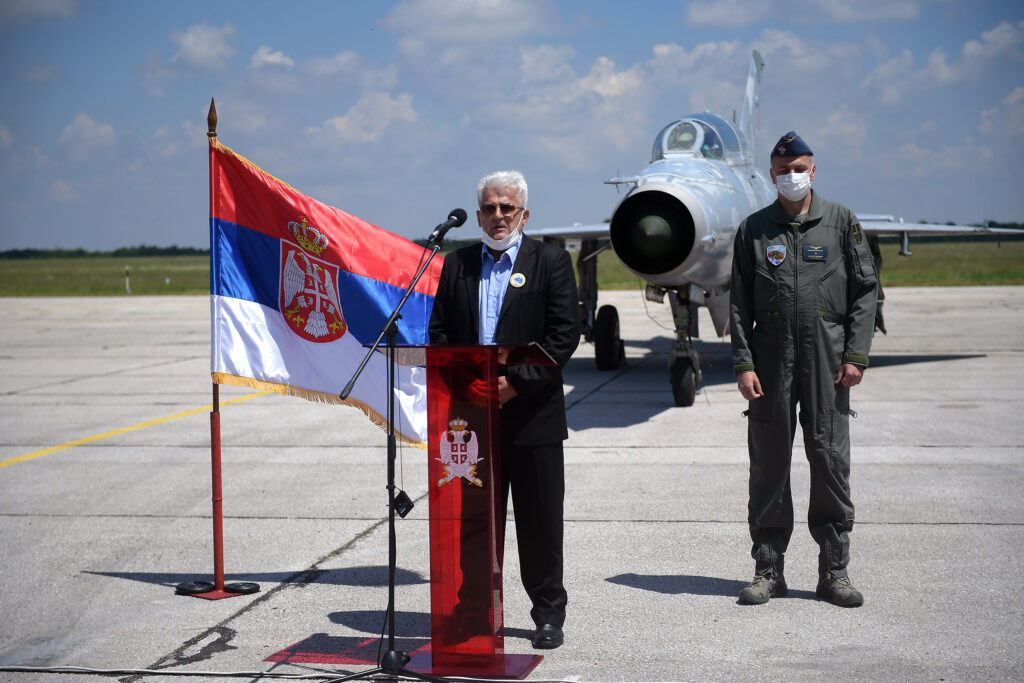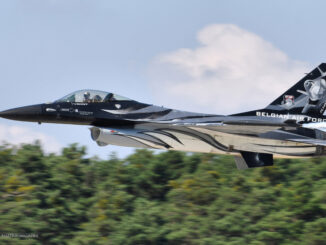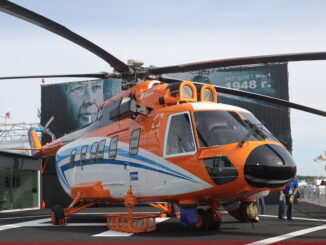 On 21st May 2021, the Serbian Air Force and Air Defence (Ратно ваздухопловство и противваздухопловна одбрана Војске Србије) has officially retired their MiG-21 fighters (NATO reporting name: Fishbed).
On 21st May 2021, the Serbian Air Force and Air Defence (Ратно ваздухопловство и противваздухопловна одбрана Војске Србије) has officially retired their MiG-21 fighters (NATO reporting name: Fishbed).
A sentimental goodbye to this legendary aircraft, after almost six decades of operational service, took place at ´Colonel Pilot Milenko Pavlović´ air base in Batajnica. The Deputy Prime Minister and Minister of Defence Nebojša Stefanović, and the Air Force and Air Defence Commander, Lieutenant General Duško Žarković were among the participants of that solemn ceremony, named ´Trace in Infinity´ (Траг у бескрају).
The first batch of MiG-21 fighters for the Air Force and Air Defence (Ратно ваздухопловство и противваздушна одбрана) – an aviation branch of the former Yugoslav People´s Army – was ordered in 1962. All newly delivered aircraft were then assigned to the 204th Fighter Aviation Regiment in Batajnica, that at the end of 1964 reported three combat-ready squadrons, being equipped with 41 MiG-21 fighters of F-13 variant. An interesting fact is that in those early years Yugoslav pilots for MiG-21s were trained on Lockheed TV-2 jets, because initially only a single-seat variant of Mikoyan fighter was purchased.
It is worth mentioning here that, at its peak, the Yugoslav Air Force operated hundreds of combat aircraft and was considered among the biggest ones in Europe. Therefore it will not come as a surprise that, until the 1980s, the aviation branch of Yugoslav armed forces has purchased 261 MiG-21 fighters in total. Those aircraft were acquired in several different variants, starting from the above mentioned F-13 and then MiG-21U, PFM, US, R, M, MF, UM and ´bis´ versions. The purchase of those fighters has opened another chapter of the Yugoslav Air Force history, being marked with a return to Soviet-made aircraft.
In order to comprehend the significance of that purchase, we must go back to 1948 and so-called Yugoslav-Soviet split. At the end of that year, as a result of conflict between Josip Broz Tito and Joseph Stalin, the Yugoslav federation broke off its relations with the Soviet Union. Plunged into economic crisis and facing a threat of Soviet invasion, Yugoslavia applied for help from the United States.

Initially, American assistance was purely economic, but later it was also enhanced with military aid. In the early 1950s, Yugoslavia was included among the countries covered by the Mutual Defense Assistance Act and received significant supplies of Western military equipment, inclusive of several aircraft. And that was the reason the first generation of Yugoslav jets was of the American provenance – T-33 Shooting Star, F-84 Thunderjet and F-86 Sabre.
Over the years it became clear that the first generation should be replaced with newer jets. The first idea was to acquire some Mirage III fighters, but this was shortly abandoned because of French colonial policy that was not acceptable for Yugoslavia. However, abandoning of the French proposal coincided with relative amelioration of Yugoslav relations with the Soviet Union being a result of so-called ´de-Stalinization´, launched at that time by N. Krushchev. As a direct consequence, Yugoslav armed forces again became interested in military equipment being manufactured in the USSR and other Eastern Bloc countries. And purchasing the MiG-21 fighter was one of the examples.
Most of the American-manufactured jets in Yugoslav service were already retired until the early 1970s, being successively replaced by consecutive variants of MiG-21 fighters and domestically made aircraft – SOKO Orao and Galeb.
Apart from the already mentioned 204th regiment, the new MiG-21 fighters were also assigned to the 117th and the 83rd Fighter Regiments, the 204th Fighter-Bomber Regiment and the 129th training centre. They quickly became a backbone of Yugoslav fighter aviation and played that role until the late 1980s. Another milestone in the Yugoslav Air Force history was reached in 1986, being marked by arrival of the first MiG-29 aircraft, representing next generation of Soviet fighters.
Nevertheless, at the beginning of 1990s, that process of another generational change in the Yugoslav Air Force was interrupted by breakup of Yugoslav federation. The period between 1991 and 1995, known as Yugoslavian wars, not only stopped any further purchases but was also a time when Yugoslav MiG-21s were used in combat. During air-to-ground operations in Croatia and Bosna, the federal forces lost at least seven aeroplanes of that type – five MiG-21bis and two MiG-21R, being shot down by anti-aircraft fire.

On 27th April 1992, with the dissolution of Yugoslav federation and creation of the Federal Republic of Yugoslavia, the aviation branch of the Yugoslav People´s Army was transferred into Air Force and Air Defence of Yugoslavia (also referred as the Air Force of Serbia and Montenegro). This new formation inherited 74 of the former Yugoslav MiG-21 fighters, being assigned to three fighter squadrons.
Also in 1992, the Croatian forces formed its first aviation unit of three ex-Yugoslav MiG-21s, brought to the country by defectors from the Yugoslav armed forces.
The year 1999 was marked by another conflict, known as Kosovo War. Although MiG-21s were already considered obsolete and not participated in aviation operations, several aircraft were destroyed on the ground, in result of NATO air raids. Depending on source, it was thirty to thirty eight MiG-21s, although the latter number is more likely. In addition, many other fighters were significantly damaged and written off in the following years.
When, in 2006, the Montenegro left the federation, the Republic of Serbia was established – and also the current Serbian Air Force and Air Defence. The new air force inherited approximately thirty MiG-21s, five MiG-29B and one MiG-29UB, however found itself in unenviable situation. The wars left their mark on the Serbian economy, arms embargo and other sanctions against the country were established, both impeding purchase of spare parts and everyday maintenance. In addition, many aircraft were at the end of their lifespan. As a consequence, the number of airworthy aircraft was decreasing each year. It was reported that last single-seat MiG-21 of the Serbian Air Force was withdrawn from operational service in 2015. Since that time, the only airworthy aeroplanes from once impressive fleet of Yugoslav MiG-21s was a pair of two-seat MiG-21UM aircraft.
However, in August 2016, the Serbian Air Force received another MiG-21UM, that returned to operational service after a five-year-long overhaul done at ´Moma Stanojlović´ aviation plant. Due to low number of airworthy aircraft in the Serbian Air Force inventory, all three two-seaters were not only used for training, but also performed regular QRA duties in mixed formation with MiG-29.

This situation has improved at the end of 2017. As a result of new approach to the armed forces by Serbian authorities, the air force received six MiG-29 fighters being donated from Russia. Another four fighters were purchased in Belarus. Nevertheless, it was still estimated that MiG-21s will remain operational at least until 2026.
Regrettably, on 25th September 2020, one of the remaining MiG-21UM aircraft crashed in the area of Brasina village, western Serbia. Its crew, Major Dejan Krsnik, commander of the 4th Aviation Section of the 101st Fighter Squadron and Captain Zvonko Vasiljević, Assistant Commander for Intelligence and Reconnaissance Activities, were killed on spot. The aircraft that crashed in Brasina was exactly the one being overhauled in 2016 and the last fully operational MiG-21 in the Serbian Air Force. This tragic event accelerated the decision of official retiring of both remaining MiG-21s from active service.
On 21st May 2021, the solemn farewell ceremony at Batajnica closed fifty-eight-year-long operational history of MiG-21 fighter in Yugoslav and then Serbian air forces.
According to Lieutenant Colonel Dejan Beda, Assistant Commander for Operations of the 204th Air Brigade – who also spent many years in cockpit of MiG-21 fighter – the story of this aircraft is inseparably connected with Batajnica air base, because every MiG-21 that was ever used by Yugoslav and Serbian military aviation has once landed and took-off from its runway.
´The veteran behind us has finished its career and is going down in history, not retirement. Today, we have mixed feelings, at least us who have spent our entire careers in the cockpit of this supersonic jet aircraft. But that veteran has indeed left an indelible trace in the skies of this country and this was exactly why this event was called “Trace in Infinity“´, stated Boriša Mandić, a former military pilot and MiG-21 instructor.
A traditional water salute given to the legendary aircraft, officially marked the end of operational service of the Serbian MiG-21 fighters.

All quotations and photos © Министарство одбране Републике Србије / MoD Republic of Serbia. MoD press releases were used.



